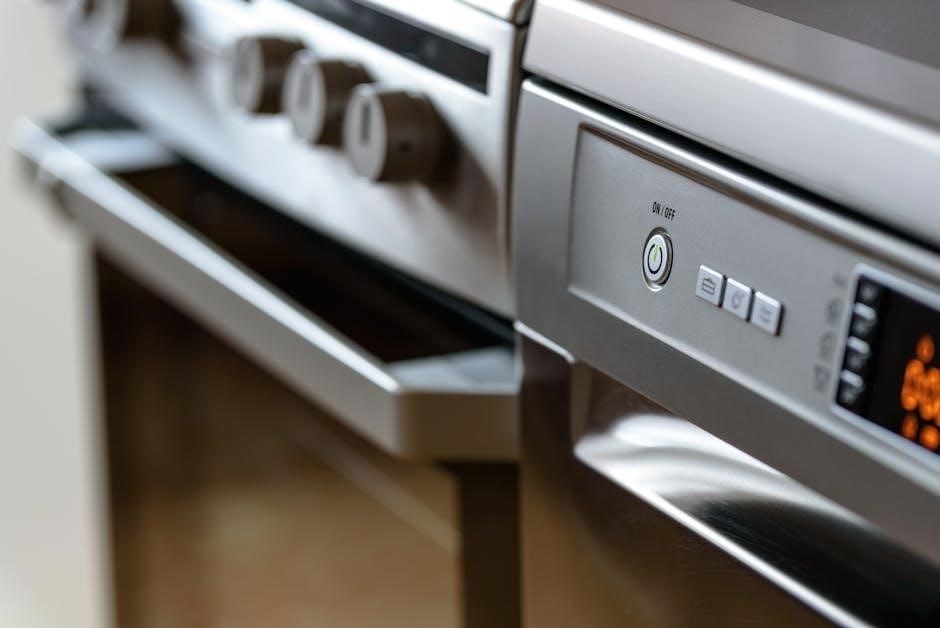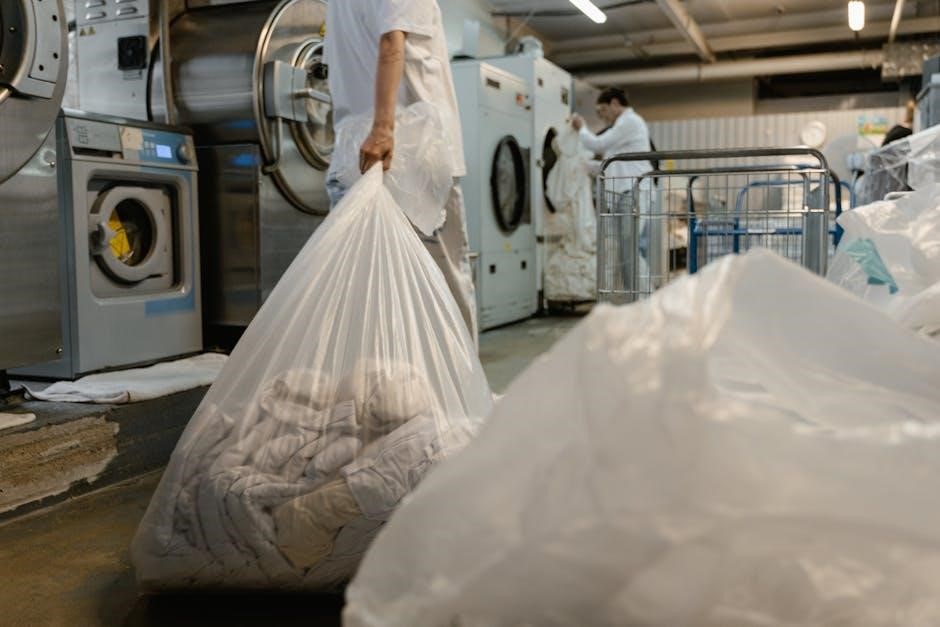Crosley Washer Manual: A Comprehensive Guide
Welcome to your ultimate resource for navigating your Crosley washer!
This comprehensive guide provides valuable information, including where to find your specific model’s manual, understand its features, and troubleshoot common issues.
Let’s ensure you get the most out of your Crosley appliance!
Finding Your Crosley Washer Manual
Locating the correct manual for your Crosley washer is the first step
towards optimal usage and maintenance. Several avenues can help you in
this search. Firstly, check the appliance itself. Many manufacturers
affix a small sticker or plate, usually on the back or inside the
washer door, containing the model number. This number is crucial for
finding the right manual.
Once you have the model number, visit the Crosley website. Most
manufacturers now offer digital versions of their manuals, easily
downloadable in PDF format. If the Crosley website doesn’t have it, try
searching broader appliance manual databases like
ManualsOnline.com. Sears Parts Direct is another excellent resource,
especially if your washer is an older model. They often have parts
diagrams and manuals available for download.
If you’re still struggling, consider reaching out to Crosley’s customer
support. They may be able to provide you with a digital copy of the
manual or guide you to a relevant resource. Remember to have your model
number handy when contacting them.
Crosley Washer Models and Manual Availability
Crosley has produced a diverse range of washing machine models over the
years, from top-loading to front-loading and compact units. Each model
has specific features and operational nuances, making the correct manual
essential. Popular models include the CAW series, such as CAW12444XW2,
and the YTW series, like YTW4514PNDG, along with others like CFW4700LW0
and VAW3584GW1.

Finding manuals for these various models often depends on the age of the
washer. Newer models typically have readily available digital manuals on
the Crosley website or through major appliance retailers. For older
models, resources like Sears Parts Direct and servicemanuals.net can be
invaluable. These sites often archive manuals and repair guides for
discontinued appliances.
When searching, always use the complete model number to ensure you find
the correct manual. Be aware that some manuals may cover a range of
similar models, so check for any specific notes or addenda that apply
to your particular machine. If you are unable to locate a free manual,
consider purchasing a service or repair manual from a reputable online
source.
Understanding Your Crosley Washer’s Control Panel and Features
The control panel on your Crosley washer is the key to customizing each
wash cycle. Common features include a variety of wash cycles designed
for different types of fabrics and soil levels. You’ll typically find
options like “Normal,” “Delicate,” “Heavy Duty,” and “Quick Wash.”
Understanding the specific purpose of each cycle ensures optimal
cleaning and garment care.

Water temperature settings are another crucial aspect of the control
panel. Options usually include “Hot,” “Warm,” and “Cold,” allowing you
to select the appropriate temperature based on the fabric and desired
cleaning intensity. Additionally, water level settings enable you to
adjust the amount of water used depending on the load size, conserving
water and energy.
Some Crosley washers also offer additional features like extra rinse
options, soil level adjustments, and delay start functions. Familiarize
yourself with these features to take full advantage of your washer’s
capabilities. Consult your user manual for detailed explanations of each
control panel setting and feature, as the specific layout and options
may vary depending on the model.
Essential Safety Instructions and Usage Guidelines
Operating your Crosley washer safely and effectively is paramount. Before
using the appliance, thoroughly review all safety instructions outlined
in your user manual. Always ensure the washer is properly grounded to
prevent electrical hazards. Never operate the washer if the power cord
or plug is damaged.
When loading the washer, avoid overloading, as this can strain the
machine and affect cleaning performance. Distribute the load evenly to
prevent imbalances during the spin cycle. Before starting a cycle,
ensure all pockets are empty and remove any loose items that could
damage the washer or clothing.
Always use the recommended amount of detergent, and follow the detergent
manufacturer’s instructions. Using too much detergent can leave residue
on clothes and in the washer. Keep the area around the washer clean and
free of obstructions. Never allow children to play near or inside the
washer. After each use, leave the washer door slightly ajar to prevent
moisture buildup and mildew growth. Regularly inspect hoses for cracks or
leaks and replace them as needed to prevent water damage.
Water Temperature and Pressure Requirements
Ensuring your Crosley washer receives the correct water temperature and
pressure is crucial for optimal performance and longevity. The household
water heater should be set to deliver water at a temperature between 120°F
and 150°F (50°C to 66°C) to the washer when a hot wash cycle is
selected. This temperature range is ideal for effectively removing stains
and sanitizing clothes.

Maintaining adequate water pressure is equally important. The water
pressure supplied to the washer must be within the range of 20 psi
(minimum) to 120 psi (maximum). Insufficient water pressure can lead to
poor cleaning performance and extended cycle times, while excessive
pressure can damage the washer’s internal components and hoses.
Regularly check the inlet hose screens for debris and clean them as
necessary to ensure a consistent water flow. Use new washers in the inlet
hoses when connecting them to prevent leaks. If you experience issues with
water temperature or pressure, consult a qualified plumber to assess
your home’s water system. Proper water temperature and pressure not only
enhance cleaning effectiveness but also contribute to the overall
efficiency and lifespan of your Crosley washer.
Troubleshooting Common Issues
Encountering issues with your Crosley washer can be frustrating, but many
common problems can be easily resolved with a bit of troubleshooting. One
frequent concern is a washer that won’t fill. This could be due to a
kinked or blocked inlet hose, insufficient water pressure, or a faulty
water inlet valve. Check the hoses for any obstructions and ensure the
water supply is turned on fully.
Another common issue is a washer that leaks. Inspect the inlet and drain
hoses for cracks or loose connections. Also, check the door seal (for
front-load washers) for damage or debris. If the washer isn’t draining
properly, the drain hose might be clogged or the drain pump could be
malfunctioning. Clean the drain hose and filter to remove any lint or
debris buildup.
If the washer is making excessive noise, it could be due to an unbalanced
load or worn-out drum bearings. Redistribute the load evenly and consider
replacing the bearings if the noise persists. For any error codes
displayed on the control panel, refer to your washer’s manual for specific
troubleshooting steps. Remember to always disconnect the power supply
before attempting any repairs. If you’re unsure about any troubleshooting
steps, consult a qualified appliance repair technician.
Maintenance Tips for Optimal Performance
To ensure your Crosley washer operates efficiently and lasts for years to
come, regular maintenance is essential. One of the most important steps is
to clean the washer regularly. Use a washer cleaner or a solution of
bleach and water to remove detergent buildup, mold, and mildew. Run a
cleaning cycle monthly to keep the washer fresh.
Also, inspect the inlet hoses regularly for cracks, bulges, or leaks.
Replace them every five years or sooner if any damage is detected. Clean
the lint filter after each load to prevent clogs and maintain proper
drainage. Periodically check the drain hose for kinks or obstructions and
ensure it is securely connected. Level the washer to prevent excessive
vibration and noise during operation.
Furthermore, avoid overloading the washer, as this can strain the motor and
reduce cleaning performance. Use the appropriate amount of detergent
according to the load size and soil level. Consider performing a
maintenance procedure, at a minimum, once per month or every 30 wash cycles
to control the rate of buildup. By following these simple maintenance
tips, you can keep your Crosley washer running smoothly and efficiently for
years.
Cleaning Your Crosley Washer
Maintaining a clean washing machine is crucial for optimal performance and
preventing unpleasant odors. Over time, detergent residue, fabric softener,
and mineral deposits can accumulate, leading to reduced cleaning
effectiveness and potential damage. Regular cleaning helps to eliminate
these buildups and keeps your Crosley washer running smoothly.
To clean your Crosley top-load washer, start by selecting the appropriate
cleaning method. You can use affresh® Washer Cleaner or liquid chlorine
bleach. For a bleach-based cleaning cycle, add one cup of liquid chlorine
bleach to the bleach dispenser. For models without a dispenser, pour the
bleach directly into the wash basket. Run a complete wash cycle with hot
water, selecting the “clean washer” or “bulky/towels” setting if available.
For front-load washers, follow the manufacturer’s instructions for using
washer cleaner or bleach. Typically, you’ll add the cleaner to the
dispenser and run a specific cleaning cycle designed to sanitize and remove
residue. Remember to wipe down the rubber gasket around the door to prevent
mold and mildew growth.
Additionally, clean the detergent dispenser regularly to prevent clogs and
buildup. Remove the dispenser drawer and rinse it thoroughly with warm
water, scrubbing away any residue. Also, remember to clean the lint filter
to ensure proper drainage.
Ordering Replacement Parts
When your Crosley washer requires a replacement part, it’s essential to
source the correct components to ensure proper fit and function. Using
factory-specified parts is highly recommended, as these are designed
specifically for your appliance and built to the same precision as the
original components. This guarantees compatibility and optimal performance.
To begin the ordering process, locate your washer’s model number. This is
typically found on a sticker or plate located on the appliance itself.
Common locations include the inside of the washer lid, the back panel, or
near the bottom front. Once you have the model number, you can visit the
Crosley website or contact their customer service department.
Several online retailers, such as Sears Parts Direct and servicemanuals.net,
also offer genuine Crosley replacement parts. When searching for parts, be
sure to enter your model number to narrow down the selection and ensure you
are viewing compatible components. You can typically find part diagrams and
schematics online, allowing you to easily identify the specific part you
need.
Before placing your order, double-check the part number and description to
confirm it is the correct item. Consider ordering from reputable suppliers
to avoid counterfeit or substandard parts that may damage your washer.
Accessing Repair Manuals and Diagrams
When facing a more complex issue with your Crosley washer, accessing repair
manuals and diagrams can be invaluable. These resources provide detailed
instructions, exploded views, and troubleshooting steps to help you diagnose
and repair your appliance effectively. Repair manuals offer a deeper dive
than the user manual, covering technical aspects and specific repair
procedures.
Several avenues exist for obtaining these resources. The Crosley website is
a primary source, often offering downloadable repair manuals and diagrams
specific to your washer model. Be sure to have your model number handy when
searching. Websites like servicemanuals.net and RepairClinic.com also
maintain extensive libraries of appliance repair manuals, including those
for Crosley washers.
Sears Parts Direct is another excellent resource, providing parts diagrams
and manuals for various Crosley models. These diagrams can be particularly
helpful in identifying specific components and their placement within the
washer. When using online resources, ensure the manual or diagram matches
your exact model number to avoid using incorrect information.
Repair manuals and diagrams are essential tools for DIY repairs, empowering
you to tackle more advanced issues with confidence. Always prioritize
safety when working on electrical appliances and consult a qualified
technician if you are uncomfortable performing any repair.

